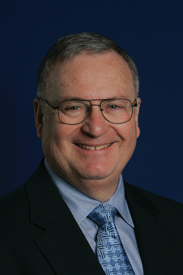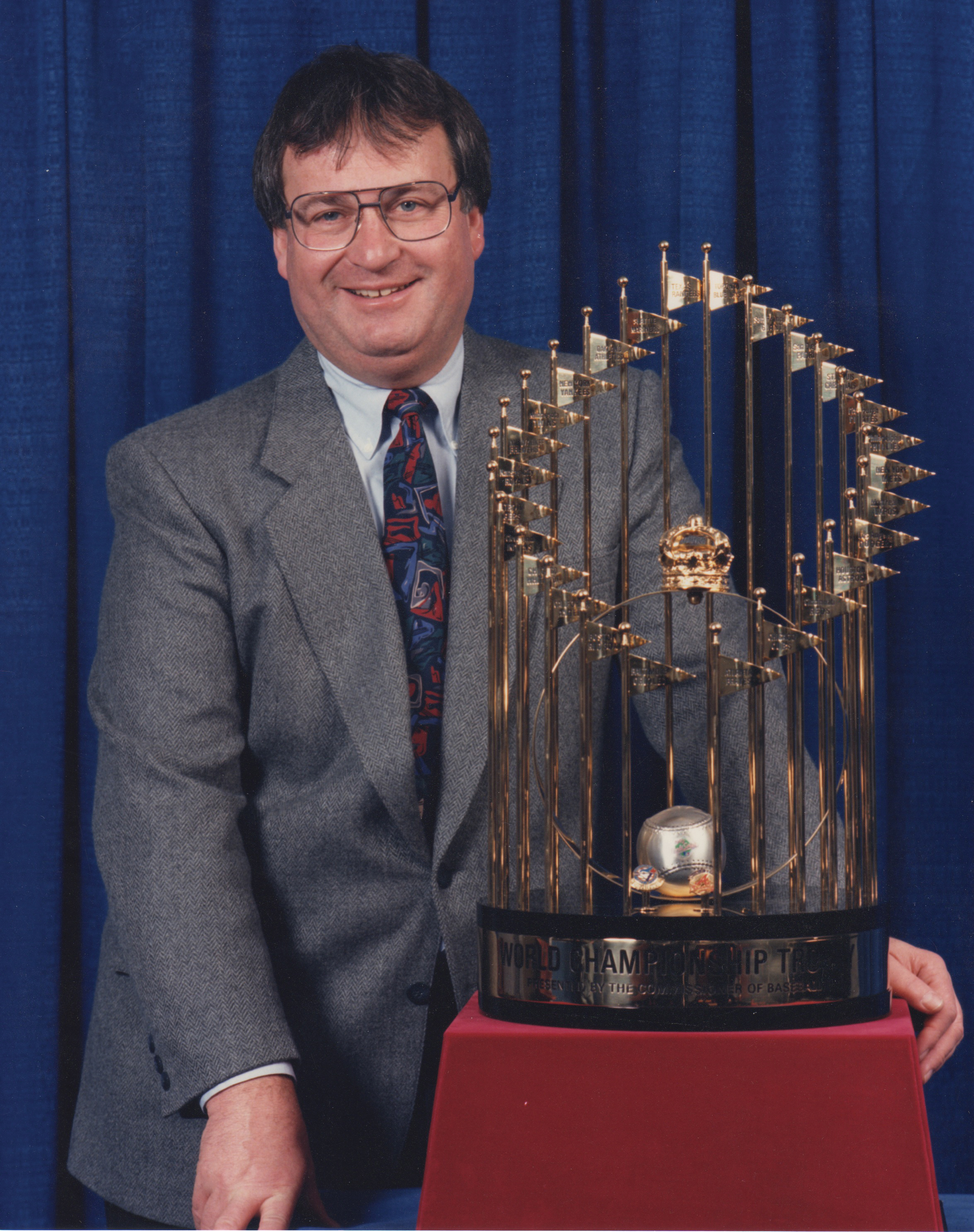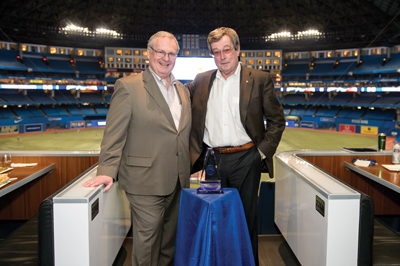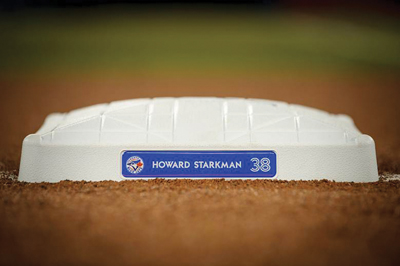H
 |
Photo: COURTESY OF HOWARD STARKMAN
|
oward Starkman, who retired earlier this year as Toronto Blue Jays vice president of special projects, enjoyed a perspective that few have shared, watching the birth, rise, fall and redevelopment of baseball in Canada’s largest city. An original employee of the club and a former publicist with the Toronto Maple Leafs, Starkman joined the Blue Jays in 1976, mere weeks after Toronto was awarded an American League franchise and before the club even had a name. He proceeded to spend 38 years with the Blue Jays, seeing them transform the stadium landscape with the 1989 opening of SkyDome, win two World Series titles, and slowly rebuild their fan base after a devastating work stoppage in 1994. In addition, he spent years as a key aide and confidante to Blue Jays President and CEO Paul Beeston. Starkman spoke recently with SportsBusiness Journal staff writer Eric Fisher.
■ I started July 4, 1976, and was arguably the fourth or fifth employee hired by the club, depending on who you talk to. Pete Bavasi hired me; he had come on board as executive vice president and general manager. Paul Beeston was already there. The first thing we did was hire a lot of people.
■ I sort of took over as public relations director, but I had experience and worked before for the Maple Leafs, and had been director of administration and publicity for them. And I had done travel and worked with the league on PR, so I ended up doing some of those things at the start to get us going.
■ The first major thing we did was have a name-the-team contest, and that’s how we came up with the Blue Jays.
■ Baseball had not been in Toronto for about 10 years after an International League team moved. But we were the major business hub of Canada. We had a lot of business, a lot of banks, a lot of breweries. There was no reason why baseball would not succeed in Toronto. We were a major market.
 |
Starkman with the1992 World Series trophy
Photo: COURTESY OF HOWARD STARKMAN
|
■ Paul’s a unique individual. He had come out of Welland, Ontario, gone to the University of Western Ontario, gained his chartered accountant designation, and he happened to be living in London [Ontario]. He was a friend of Don McDougall, who was the president of Labatt. And Paul had the opportunity, always being a big baseball fan, to do baseball here, and he grew immensely in the sport.
■ He’s a quick learner, and a people person. And he’s contributed a lot to what the organization has done over the last 38 years. His intelligence, I think, is underestimated by a lot of people because he’s sort of an outgoing, back-slapping type of person. But he’s very bright and gets along with everyone in the industry.
■ Even when he was out of the industry for a while, he continued to keep up with Reinsdorf, Manfred, Selig, and those kind of people in the business. He does that constantly now, and it’s amazing to see him operate.
■ We finally put it all together in ’92, and again in ’93. They were two wonderful years, but actually, the entire 11-year run [from 1982-93] was really quite outstanding when you step back and look at it all.
■ I wonder if we had won in ’85 [when the Blue Jays blew a 3-1 ALCS lead to Kansas City] if the interest would have grown as much, as by the ’90s, we would have been there, done that. But the fact we kept it going for all those years before we won kept the interest growing.
■ The SkyDome really added a lot. At the time, it was state of the art. The retractable roof is still amazing. But the one thing you realize now is that you probably don’t need a stadium that size.
■ The strike came in ’94, and that put a big damper on the business completely. We had 27,000 season tickets in ’93. We had the highest payroll in the league, and we thought we could sustain it with the crowds we were getting. But the strike just killed us. By the time we got going in ’95, we lost a lot of our season-ticket holders and weren’t able to capture them back.
 |
Starkman with Blue Jays President and CEO Paul Beeston. The Blue Jays named their Employee of the Year award for Starkman when he retired.
Photo by: MICHELLE PRATA
|
■ It was a huge hit for us. We were never able to recover fully. We’re still working at it now.
■ Even now, to get to 2.5 million in attendance or 2.7 million, it takes a lot to get to that level. I knew that 4 million wasn’t necessarily a realistic number. But I thought given the market we had and the tourist business we have, it would be hard to go below 3 million. But it happened.
■ Toronto has always been very fortunate as a newspaper town. We still have four papers here that cover the team. Not many cities have that anymore. And we have a number of network TV stations and a number of sports TV stations. So it’s a huge media market.
■ Back in the ’80s, the key beat writers knew where to get their information, whether they worked scouts from other teams, or scouts from our team. But they were able to break news. Nowadays, it’s much more difficult. Information gets out so quickly, and it’s difficult for anybody to say they broke a story.
■ The other thing you notice is that the writing, particularly the game stories, is all the same. It’s all the same quotes. In the old days, I remember going in the clubhouse and there’d be a few writers going to different players to get their stories. Now, everything’s organized, the PR directors bring the players out and everybody has the same quotes. So when you pick up the papers the next day, everybody’s basically got the same story.
■ People often forget that a lot of players we had in the ’80s were pretty good. But I think the athletes now are very good. There’s a lot of skill. But there doesn’t seem to be as many superstars in the game.
■ They obviously have a lot more reliance on the bullpen. A guy like Dave Stieb, he threw over a hundred complete games for us. Nowadays, you’re lucky if somebody does two or three a year.
 |
Base tags on April 10 saluted Starkman’s years of service.
Photo: COURTESY OF HOWARD STARKMAN |
■ When we started, the first pitcher I saw actually do arm exercises for his rotator cuff was Doyle Alexander. That was like ’84-’85. Before that, I probably have more weights in my basement than we did at the stadium.
■ I’m still doing some consulting, and I’m going to help out to transition some of the jobs. And I’m committed to the postseason that if we get there, I’ll be helping out to coordinate our activities with MLB.
■ Last year was a difficult one. The organization made the big trade ... getting R.A. Dickey from the Mets, and signing [Melky] Cabrera. And things didn’t work out. But [general manager] Alex Anthopoulos and Paul stood their ground, and so far this year, it’s been pretty good. … If our team can stay healthy, it should be a good run toward the end.







